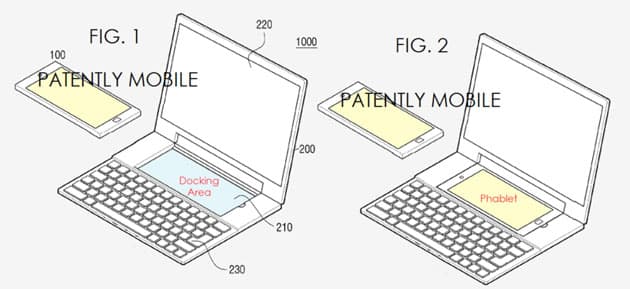Plug In An Android Phablet Into A Notebook To Boot Windows? Samsung Has A Patent For That
Ever since Samsung’s grip on the smartphone market started to fade thanks to rise of feature packed mid-range offerings from Chinese brands, it has started to pursue relationships with unlikely partners. For example, it is now allowing Microsoft-built apps to be installed on its Android phablets by default. Today, however the careful eyes of <a href="https://www.patentlymobile.com/2015/05/samsung-invents-a-phablet-dock-for-a-next-gen-dual-os-notebook.html" target="_blank" rel="nofollow noopener noreferrer">Samsung invents a Phablet Dock for a Next-Gen Dual OS Notebook - Patently Mobile</a> came across a recently made public patent record from the United States Patent & Trademark Office that shows Microsoft and Samsung could be interested in taking their partnership to the next level. The patent application was filed by the Korean electronics giant sometime in 2014 about a dual-OS booting device. Unlike the <a href="https://www.crazyengineers.com/threads/asus-dual-os-devices-postponed-indefinitely.73906">Asus Dual-OS Devices Postponed Indefinitely</a> idea this one has a potential to become a reality.

So what is this theoretical device anyway? It’s basically a notebook with a smartphone dock. You simply put your phablet, say a Samsung Galaxy Note in the cradle and it acts as the brain for the notebook. This is radically different from the Transformer Book V concept that allowed you to cradle your Android smartphone into a Windows 8.1 notebook and access it on the laptop screen. Things take another interesting turn when you notice that once the smartphone is in the cradle it has the ability to switch to Windows. The statement also says that other operating system apart from Windows can also be applied. This means Samsung will be free to go with its home grown Tizen OS as well. The question that remains unanswered here is that, will the Android side of the phablet remain active while it is serving as Windows for the notebook? Probably not, because one section of the patent application states that the touchscreen of the phablet can serve as a touch pad for the notebook.
Ardent followers of Microsoft must be inquisitive about that fact that why Samsung went through all this trouble when the Redmond giant has planned a “continuum†feature that allows you to hook up a Bluetooth keyboard and mouse and a HDMI equipped display on a Windows 10 smartphone to enjoy a full desktop experience. Well we are also thinking the same. The patent application does not say whether the dock has a battery or any ports such as USB or HDMI or it has storage of its own. Since this is still an idea on paper it might takes years to become a reality or it may not even see the light of the day.

So what is this theoretical device anyway? It’s basically a notebook with a smartphone dock. You simply put your phablet, say a Samsung Galaxy Note in the cradle and it acts as the brain for the notebook. This is radically different from the Transformer Book V concept that allowed you to cradle your Android smartphone into a Windows 8.1 notebook and access it on the laptop screen. Things take another interesting turn when you notice that once the smartphone is in the cradle it has the ability to switch to Windows. The statement also says that other operating system apart from Windows can also be applied. This means Samsung will be free to go with its home grown Tizen OS as well. The question that remains unanswered here is that, will the Android side of the phablet remain active while it is serving as Windows for the notebook? Probably not, because one section of the patent application states that the touchscreen of the phablet can serve as a touch pad for the notebook.
Ardent followers of Microsoft must be inquisitive about that fact that why Samsung went through all this trouble when the Redmond giant has planned a “continuum†feature that allows you to hook up a Bluetooth keyboard and mouse and a HDMI equipped display on a Windows 10 smartphone to enjoy a full desktop experience. Well we are also thinking the same. The patent application does not say whether the dock has a battery or any ports such as USB or HDMI or it has storage of its own. Since this is still an idea on paper it might takes years to become a reality or it may not even see the light of the day.
0
